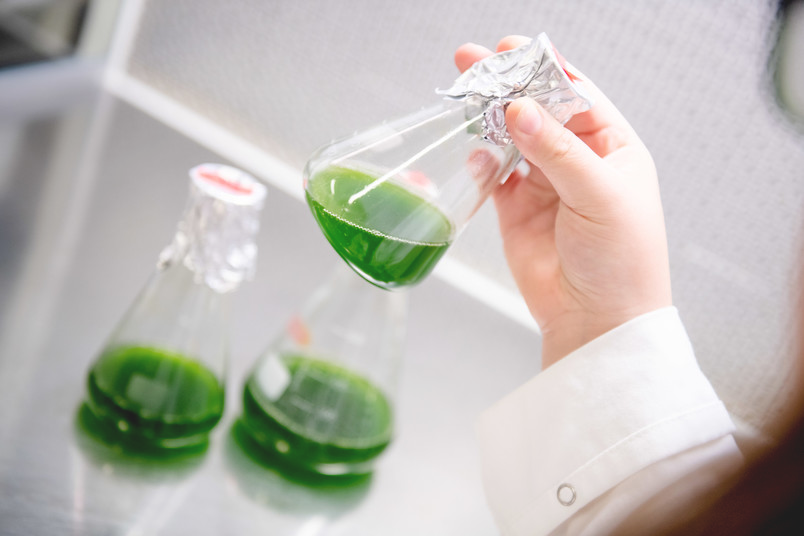Jul 3 2020

Algae hold great potential for environmentally friendly energy production. Image Credit: © RUB, Marquard.
A Bochum-based interdisciplinary research group has achieved a breakthrough that could result in more environmental safety in the chemical sector.
Several substances used in day-to-day life work only in the correct three-dimensional (3D) structure. Natural enzymes could be used to synthesize such substances in an eco-friendly manner–if they do not require a co-substrate that is very costly to produce until now.
At Ruhr-Universität Bochum (RUB), a research group has precisely identified the essential enzymes present in unicellular green algae. Still improved: living algae can be utilized as biocatalysts for specific substances, and they bring the co-substrate along with them, generating it in an eco-friendly way via photosynthesis. The researchers published their report in the Algal Research journal on June 17th, 2020.
It’s a Question of 3D Structure
Various chemical substances used in medicines, food, or cosmetics can take up somewhat different three-dimensional structures, where only one of them produces the preferred medical or fragrance effect.
The chemical synthesis of the ideal substances is not always eco-friendly, as it needs specific solvents or high temperatures. But in nature, specific proteins produce the necessary product in water and at mild temperatures. And during this process, they generally produce the precise 3D structure of the substance that is required by the industry.
Old Yellow Enzymes Require an Expensive Additive
Old yellow enzymes (OYEs) get their name for their natural yellow color. They appear in plants, fungi, and bacteria, are well examined and exhibit significant potential for a bio-based economy.
But these yellow enzymes have one drawback. To perform their reaction, they require the co-substrate called NADPH (which stands for nicotinamide adenine dinucleotide phosphate). This tiny molecule is produced via metabolic processes in living cells, but its chemical production is very costly. Thus, OYEs are not commercially used much.
OYEs From Unicellular Green Algae: Two Birds with One Stone?
Many OYEs in unicellular green algae have been identified by the Bochum researchers.
For a broad application, industry needs OYEs that can also produce unusual molecules. Algae possess very complex metabolic pathways and are therefore ideal sources for novel biocatalysts.
Thomas Happe, Professor and Head, Photobiotechnology Research Group, Ruhr-Universität Bochum
The scientists investigated algal OYEs in the test tube and demonstrated that they are capable of transforming several commercially viable substances.
The exciting thing is that living algae can also carry out the reactions needed in the industry. Since algae produce NADPH using photosynthesis, i.e. with sunlight, the co-substrate of the OYEs is supplied in an environmentally friendly and cost-effective way.
Stefanie Böhmer, Study Lead Author and PhD student, Ruhr-Universität Bochum
Promising Collaboration
The authors indicate that the study illustrates the significance of the collaboration between scientists from various disciplines and that the industry can be a beneficial partner to start the fundamental research.
Four scientists from the Research Training Group “Micon – Microbial substrate conversion,” financially supported by the German Research Foundation, contributed their knowledge to the study.
The concept for this project came from Solarbioproducts Ruhr, a spin-off launched by Wirtschaftsförderungsgesellschaft Herne and Thomas Happe with the goal to develop ideas for eco-friendly algae biotechnologies.
We have taken a big step towards a green industry. This would not have been possible without collaboration.
Thomas Happe, Professor and Head, Photobiotechnology Research Group, Ruhr-Universität Bochum
Funding
The project was financially supported by the German Research Foundation in the Research Training Group GRK 2341 Microbial Substrate Conversion Micon, the Chembiocat project supported by the Ministry of Innovation, Science and Research NRW, and Wirtschaftsförderungsgesellschaft Herne.
Journal Reference:
Böhmer, S., et al. (2020) Evolutionary diverse Chlamydomonas reinhardtii Old Yellow Enzymes reveal distinctive catalytic properties and potential for whole-cell biotransformations. Algal Research. doi.org/10.1016/j.algal.2020.101970.